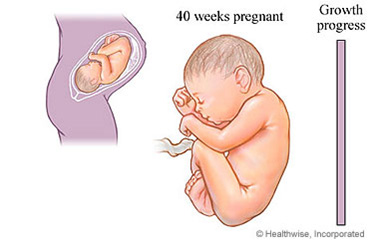Weeks 39 to 40 of Your Pregnancy

During these final weeks, you may be getting anxious to see your new baby. You may wish you could know when you are going to start labor. Or you may be thinking about whether you want to have pain medicines during labor.
Newborn babies often look different from what you may have seen in pictures or movies. Right after birth, their heads may seem strangely shaped, their eyes are puffy, and their genitals swollen. They may have very dry skin, or red marks on the eyelids, nose, or neck. Still, most parents think their babies are beautiful.
Most women deliver their babies between 37 and 41 weeks. After 41 weeks, your doctor may become concerned about a safe birth. He or she may recommend giving you medicines to start labor or scheduling a Cesarean delivery.
This care sheet can help you prepare for labor and delivery. It also gives you information about crying, bathing, bowel patterns, and how to care for your baby's umbilical cord or circumcised penis.
Follow-up care is a key part of your treatment and safety. Be sure to make and go to all appointments, and call your doctor if you are having problems. It’s also a good idea to know your test results and keep a list of the medicines you take.
How can you care for yourself at home?
Learn about birth after 41 weeks
- After 41 weeks, your baby may be harder to deliver.
- The placenta may no longer be able to meet your baby’s needs.
- The baby might have a bowel movement into the amniotic fluid, which could go into the baby's lungs.
- Your doctor will measure the amount of fluid surrounding the baby and test your baby's movement and heart rate.
- If your baby seems strong and well, your doctor might give you medicine to start labor.
- If there are other concerns, your doctor may tell you that a Cesarean delivery would be best for you and your baby.
Learn how labor can be started
- If you and your baby are both healthy and ready, and if your cervix has started to open, your doctor may "break your water" (rupture the amniotic sac). This often starts labor.
- If your cervix is not quite ready, you may get a medicine called Pitocin through an IV to start contractions.
- If your cervix is still very firm, you may have prostaglandin tablets (misoprostol) given to you orally or placed in your vagina to soften the cervix.
Learn about pain relief choices
- Pain is different for every woman. Discuss your feelings about pain with your doctor.
- If you choose a natural birth and would like to use few or no painkillers, know what pain medicines can be given through a shot or IV.
- If you choose to dull the pain as labor starts, you could have a spinal or an epidural. With these medicines, you will be alert but numb from the chest down.
- Be sure to tell your doctor about your pain medicine choice before you start labor or very early in your labor. You may be able to change your mind as labor progresses.
- Rarely, a woman is put to sleep by medicine given through a mask or an IV.
Learn about crying
- It is common for babies to cry for 1 to 3 hours a day. Some cry more, some cry less.
- Babies do not cry to make you upset or because you are a bad parent.
- Crying is how your baby communicates. Your baby may be hungry; have gas; need a diaper change; or feel cold, warm, tired, lonely, or tense. Sometimes babies cry for unknown reasons.
- If you respond to your baby's needs, he or she will learn to trust you.
- Try to stay calm when your baby cries. Your baby may get more upset if he or she senses that you are upset.
Know how to care for your newborn
- Your baby's umbilical cord stump will drop off on its own, usually between 1 and 2 weeks. To care for your baby's umbilical cord area:
- Clean the area at the bottom of the cord 2 or 3 times a day. Your baby’s doctor may suggest that you use rubbing alcohol instead of soap and water. If you use alcohol, first apply a gentle lotion around the stump to protect your baby's skin.
- Pay special attention to the area where the cord attaches to the skin.
- Keep the diaper folded below the cord.
- Use a damp washcloth or cotton ball to sponge bathe your baby until the stump has come off.
- Your baby's first dark stool is called meconium. After the meconium is passed, your baby will develop his or her own bowel pattern.
- Some babies, especially breast-fed babies, have several bowel movements a day. Others have one or two a day, or one every 2 to 3 days.
- Breast-fed babies often have loose, yellow stools. Formula-fed babies have more formed stools.
- If your baby's stools look like little pellets, he or she is constipated. After 2 days of constipation, call your baby’s doctor.
- If your baby was circumcised:
- Gently rinse his penis with mild soap and warm water after every diaper change. Do not try to remove the film that forms on the penis. This film will go away on its own. Pat dry.
- Put petroleum ointment, such as Vaseline, on the area of the diaper that will touch your baby’s penis. This will keep the diaper from sticking to your baby.
- Ask the doctor about giving your baby acetaminophen (Tylenol) for pain. Do not give aspirin to anyone younger than 20. It has been linked to Reye's syndrome, a serious illness.

